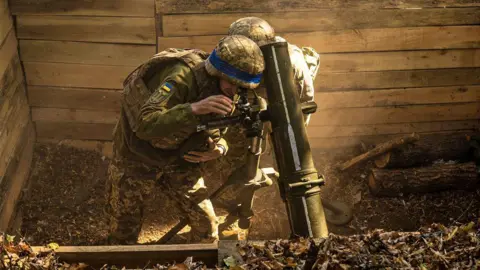 Getty Images
Getty ImagesThe tone is dark, even angry.
“The situation is getting worse every day.”
“We don’t see the goal. Our land is not here.”
Almost four months after Ukrainian troops launched a lightning offensive into the Russian region of Kursk, text messages from soldiers fighting there paint a dismal picture of a battle they don’t properly understand and fear they might be losing.
We’ve been in contact, via Telegram, with several soldiers serving in Kursk, one of whom has recently left. We’ve agreed not to identify any of them.
None of the names in this article are real.
They speak of dire weather conditions and a chronic lack of sleep caused by Russia’s constant bombardment, which includes the use of terrifying, 3,000kg glide bombs.
They’re also in retreat, with Russian forces gradually retaking territory.
“This trend will continue,” Pavlo wrote on 26 November. “It’s only a matter of time.”
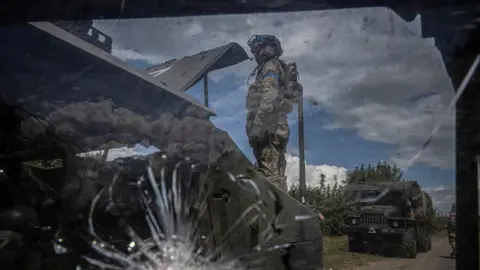 Reuters
ReutersPavlo spoke of immense fatigue, the lack of rotation and the arrival of units, made up largely of middle-aged men, brought directly from other fronts with little or no time to rest in between.
To hear soldiers complain – about their commanding officers, orders and lack of equipment – is hardly unusual. It’s what soldiers often do in difficult circumstances.
Under immense pressure from the enemy and with winter setting in, it would be surprising to hear much optimism.
But the messages we’ve received are almost uniformly bleak, suggesting that motivation is a problem.
Some questioned whether one of the operation’s initial goals – to divert Russian soldiers from Ukraine’s eastern front – had worked.
The orders now, they said, were to hang onto this small sliver of Russian territory until a new US president, with new policies, arrives in the White House at the end of January.
“The main task facing us is to hold the maximum territory until Trump’s inauguration and the start of negotiations,” Pavlo said. “In order to exchange it for something later. No-one knows what.”
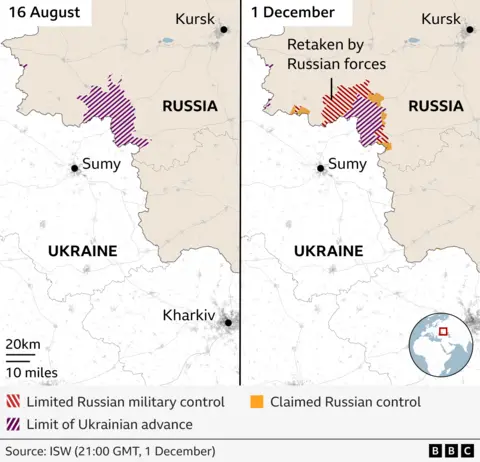
Towards the end of November, President Zelensky indicated that both sides had the change of US administration in mind.
“I am sure that he [Putin] wants to push us out by 20 January,” he said.
“It is very important for him to demonstrate that he controls the situation. But he does not control the situation.”
In an effort to help Ukraine thwart Russian counterattacks in Kursk, the US, UK and France have all permitted Kyiv to use long-range weapons on targets inside Russia.
It doesn’t seem to have done much to lift spirits.
“No-one sits in a cold trench and prays for missiles,” Pavlo said.
“We live and fight here and now. And missiles fly somewhere else.”
Atacms and Storm Shadow missiles may have been used to powerful, even devastating, effect on distant command posts and ammunition dumps, but such successes seem remote to soldiers on the front lines.
“We don’t talk about missiles,” Myroslav said. “In the bunkers we talk about family and rotation. About simple things.”
For Ukraine, Russia’s slow, grinding advance in eastern Ukraine underlines the necessity of clinging on in Kursk.
In October alone, Russia was able to occupy an estimated 500 sq km of Ukrainian territory, the most it’s taken since the early days of the full-scale invasion in 2022.
By contrast, Ukraine has already lost around 40% of the territory it seized in Kursk in August.
“The key is not to capture but to hold,” Vadym said, “and we’re struggling a bit with that.”
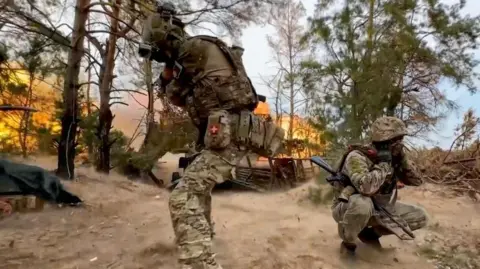 EPA
EPADespite the losses, Vadym thinks the Kursk campaign is still vital.
“It did manage to divert some [Russian] forces from the Zaporizhzhia and Kharkiv regions,” he said.
But some of the soldiers we spoke to said they felt they were in the wrong place, that it was more important to be on Ukraine’s eastern front, rather than occupying part of Russia.
“Our place should have been there [in eastern Ukraine], not here in someone else’s land,” Pavlo said. “We don’t need these Kursk forests, in which we left so many comrades.”
And despite weeks of reports suggesting that as many as 10,000 North Korean troops have been sent to Kursk to join the Russian counter-offensive, the soldiers we’ve been in contact have yet to encounter them.
“I haven’t seen or heard anything about Koreans, alive or dead,” Vadym responded when we asked about the reports.
The Ukrainian military has released recordings which it says are intercepts of North Korean radio communications.
Soldiers said they had been told to capture at least one North Korean prisoner, preferably with documents.
They spoke of rewards – drones or extra leave – being offered to anyone who successfully captures a North Korean soldier.
“It’s very difficult to find a Korean in the dark Kursk forest,” Pavlo noted sarcastically. “Especially if he’s not here.”
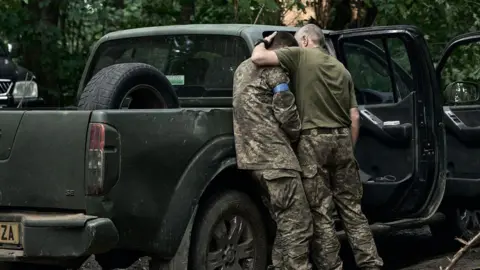 Getty Images
Getty ImagesVeterans of previous doomed operations see parallels in what’s happening in Kursk.
From October 2023 until July this year, Ukrainian forces attempted to hold onto a tiny bridgehead at Krynky, on the left bank of the Dnipro River, some 25 miles (40km) upstream from the liberated city of Kherson.
The bridgehead, initially intended as a possible springboard for advances further into Russian-held territory in southern Ukraine, was eventually lost.
The operation was hugely costly. As many as 1,000 Ukrainian soldiers are thought to have been killed.
Some came to see it as a stunt, designed to distract attention from the lack of progress elsewhere.
They fear something similar might be happening in Kursk.
“Good idea but bad implementation,” says Myroslav, a marine officer who served in Krynky and is now in Kursk.
“Media effect, but no military result.”
Military analysts insist that for all the hardship, the Kursk campaign continues to play an important role.
“It’s the only area where we maintain the initiative,” Serhiy Kuzan, of the Ukrainian Security and Cooperation Centre, told me.
He acknowledged that Ukrainian forces were experiencing “incredibly difficult conditions” in Kursk, but said Russia was devoting vast resources to ejecting them – resources which it would prefer to be using elsewhere.
“The longer we can hold this Kursk front – with adequate equipment, artillery, Himars and of course long-range weapons to strike their rear – the better,” he said.
In Kyiv, the senior commanders stand by the Kursk operation, arguing that it’s still reaping military and political rewards.
“This situation annoys Putin,” one said recently, on condition of anonymity. “He is suffering heavy losses there.”
As for how long Ukrainian troops would be able to hold out in Kursk, the answer was straightforward.
“As long as it is feasible from the military point of view.”

